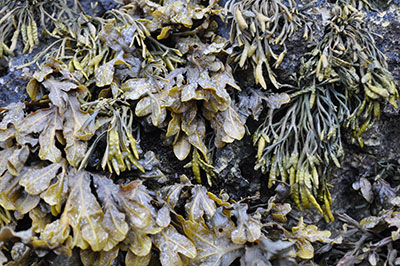
Call for beachgoers to help survey seaweed this summer
The Marine Conservation Society and Natural History Museum’s Big Seaweed Search Week returns from 29 July – 4 August. The two organisations will be asking people across the UK to head to the coast and spot seaweed as part of a citizen science project, the Big Seaweed Search.
Some seaweeds absorb carbon more effectively than trees, storing an estimated 175 million tonnes each year – equal to 10 per cent of the world’s car emissions. Scientists at the Marine Conservation Society and Natural History Museum want to find out more about the distribution and types of seaweed around the UK to help revive and protect our marine life.
Hannah Bester, Volunteering & Citizen Science Senior Manager, at the Marine Conservation Society, said, “Seaweed plays a crucial role in marine ecosystems and helps to mitigate the effects of climate change. But we want to know more about it. The more data we gather through our Big Seaweed Search, the more knowledge and influence we have to protect our ocean, and seaweeds, for the future.
“It’s easy for anyone to get involved in Big Seaweed Search Week – you don’t need to be a seaweed expert or live near the sea, just one visit to the coast will do. Seaweeds can tell us a lot about wider ocean and environmental conditions, and the information supports vital scientific research.”

Image: Richard Harrington
Although there are more than 650 species of seaweed found in the UK, Big Seaweed Search Week asks beachgoers to identify just 14 of the most commonly found. This information helps the Marine Conservation Society and the Natural History Museum to map the distribution of specific species and collect long-term data. This in turn enables them to measure the impact of environmental changes on the ocean.
The Big Seaweed Search gathers information on species, such as kelp, which are known to be affected by rising sea temperatures, the arrival of non-native species and ocean acidification. Populations of kelp are reported to be declining around the world, reducing the the ocean’s capacity to absorb carbon and fight the climate crisis.
The data gathered by volunteers helps build a picture of how our shores are changing, informing scientists and decision-makers how best to protect them.
Lucy Robinson, Community Science Manager, Natural History Museum said, “The Big Seaweed Search has already had big impacts scientifically, with data feeding into the UK Red List for seaweed species of conservation concern, and an academic paper sharing the results so far with the global research community. It’s also inspired similar projects in other countries including South Georgia and Mexico. It’s amazing to collaborate with community scientists who care about healthy seas as much as we do.”
It’s easy to get involved in Big Seaweed Search Week, and anyone can take part. Training videos and downloadable resources are available, including a guide which helps beachgoers to identify the seaweed species they’re likely to spot and explains what they need to do.
The survey can be carried out as an individual or in groups, and once information has been collected, can be completed on a mobile, tablet or computer.
To get involved simply:
- Register to take part and download your guide and recording form at www.bigseaweedsearch.org
- Choose your 5m stretch of coastline to survey
- Fill in your survey form
- Take LOTS of clear, close-up photographs for your survey to be accepted
- Submit your survey through bigseaweedsearch.org
You can visit the Big Seaweed Search website for all the information you’ll need to get started.
The post Call for beachgoers to help survey seaweed this summer appeared first on All At Sea.
